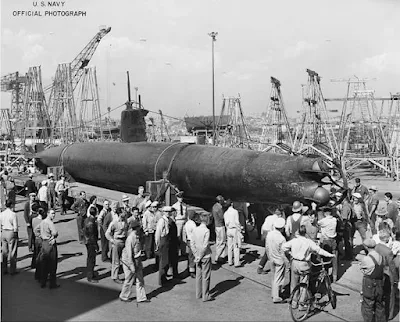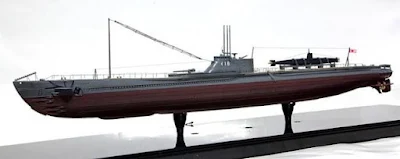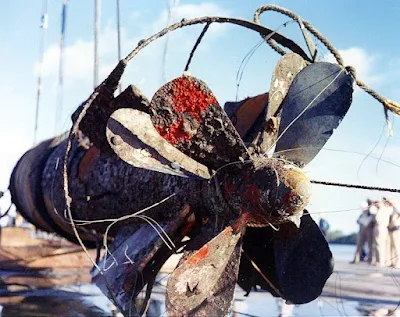by Daniel F. Gilmore
Published in 1974
Thirty-three years later, a mystery still surrounds one of the five Japanese midget subs that secretly entered Pearl Harbor during the 7 December 1941 attack that thrust the U.S. into World War II.
The question: What happened to the two-man crew of Midget D, which was found 13 June 1960, by Navy student divers seventy-six feet below the surface of the entrance to Pearl Harbor?
“Her torpedoes were still in their tubes, her hatch undogged, and, although her hull was encrusted with coral she appeared to be structurally sound and a determination was made to raise her,” Lieutenant Commander A. J. Stewart wrote in the December 1974 issue of the U.S. Naval Institute’s Proceedings.
Stewart recounted the saga of the five battery-powered subs, each eighty feet long and weighing fifty-six tons, that spearheaded the Japanese assault on Pearl Harbor.
Each midget sub was launched at sea from the deck of a mother sub shortly after midnight, 6 December 1941.
At one point, Stewart recounted: “The crews of the special attack unit could watch the dancing neon signs along Waikiki beach. Rows of landing lights at Hickam Air Base and John Rodgers Airfield blazed like jewels. Haunting strains of jazz music drifted from shore radios and honky-tonks, but all were too excited and busy to notice.
“A malfunctioning gyrocompass in the midget carried by I-24 remained defective in spite of all efforts to fix it. The midget’s young skipper, Ensign Sakamaki, was asked by I-24’s commander if he still wanted to go.
“Determined to perform the mission for which all his military training had prepared him, he replied without hesitation ‘Captain, I am going ahead… on to Pearl Harbor!’ ”
Midget A, another sub apparently cruising on the surface, became the first casualty of the Pacific war an hour before the surprise Japanese air assault on Pearl. The U.S.S. Ward, an inshore patrol destroyer, sent her to the bottom with a shot from her 4-inch guns that pierced the sub’s hull.
Midget A sank in 1,000 feet of water with her two-man crew, and is still on the bottom.
A little later, Midget B launched one of her two 18-inch torpedoes at the U.S. seaplane tender Curtis, missed and hit a pier at Pearl City. The destroyer Monaghan spotted the sub, rammed it with a glancing blow and finished it off with depth charges.
Midget B later was retrieved from the harbor bottom. The two bodies within were removed and buried with military honors, and the sub became fill material for a new pier at the Pearl Harbor sub base.
Ensign Sakamaki’s ill-fated boat, Midget C, hit reefs while trying to enter the harbor. Her batteries began leaking chemicals which almost suffocated the two crewmen.
After drifting all night on the surface with dead motors, Sakamaki and Petty Officer Inagaki lit the fuse to a self-destruct bomb and abandoned ship. Inagaki drowned. Sakamaki was washed ashore unconscious on 8 December at Waimanalo Bay, fifty miles from Pearl Harbor, and became America’s first POW of the war.
The self-destruct bomb was a dud, and Midget C washed ashore to become the key attraction in a coast-to-coast U.S. War Bond drive. The submarine ended up as an exhibit at the Key West, Florida, Lighthouse Museum.
Midget E is assumed to have been a victim of one of four U.S. destroyers that dropped depth charges after they reported being under attack by an enemy submarine. The wreckage of Midget E has never been found.
Stewart described the scene when Midget D was raised. “There followed the first, dramatic entry into the sub as Captain H. A. Thompson pried open the conning tower hatch and climbed down into the sub.
“In the dark, muddy interior, bent piping, a door twisted off its hinges, her large electric motor torn from its mountings and much battered glass gave mute evidence that Midget D had suffered great damage from depth charges.
“However, no trace of documents or crew was found. No bone fragments or teeth were found. Experts agree that even if human remains had disintegrated over the two decades, the victims’ teeth would have resisted the water’s corrosive effects.
“Second, a study of the small lengths of time fuse found, along with detonators, indicated that inasmuch as sulfur was still present in the fuse, the scuttling charge had never been activated.”
The two still-live torpedoes were cemented by corrosion into their tubes and could not be removed. So the bow section was unbolted and dumped with them into the sea.
At the request of Masayaki Harigai, Japanese Consul General in Hawaii, Midget D was returned to Japan and is now on display at the Japanese Naval Academy at Ewa Jima.
“But what of her crewmen?” Stewart asks.
“The conning tower hatch of Midget D was undogged, an action that had to be accomplished from inside the boat. Little doubt exists that her two-man crew left the sub. Whether or not they survived remains a mystery.
“If they were in the craft during the depth charge explosions, which caused extensive damage inside, they probably suffered gross injury.
If they escaped from their boat after it had settled to the bottom, it would have been possible for them to reach the surface.
“If they were able to swim the mile to shore across placid Keehi Lagoon, they could have easily melted into the local populace of Hawaii with its many Orientals.
“Had they been able to do this, their determination to avoid capture might have caused them to seek aid from those friendly to their cause, a difficult task indeed.
“Their devotion to Japanese ideology would likely have caused them to reveal to no one, either during or after the war, that they failed their mission.
“Therefore, it is a remote possibility that one or both may be alive today.”
Type A Midget Submarine Data
Displacement submerged: 46 metric tons.
Dimensions: 23.9 × 1.8 meters.
Crew: two.
Armament: two 18-inch torpedo tubes with one torpedo each.
Machinery: one electric motor, 600-horsepower.
Speed: 23 knots surfaced; 19 knots submerged (55 minutes).
Radius: 129 kilometers at 2 knots submerged.
Further Reading
For further reading, besides the issue of USNI Proceedings already cited, articles covering various aspects of the subject can be found in the August 1952, December 1961 and December 1968 issues of Proceedings.
For additional data on the submarines themselves, see:
Watts, A. J. Japanese Warships Of World War II. Doubleday, Garden City, New York, 1966.
Watts, A. J., and B. G. Gordon. The Imperial Japanese Navy. Doubleday, Garden City, New York, 1971.
 |
| The disassembled midget submarine HA-19 at Pearl Harbor, December 1941. |
 |
| Museum display model of a Type A midget submarine. |
 |
| Type A midget submarine. |
 |
| Map of Oahu showing Pearl Harbor and other installations and cities, operating areas of Japanese submarines assigned to the Pearl Harbor attack, and the location of Midgets A, B, C and D were found. |
 |
| Salvaging a Japanese midget submarine, 1945. |
 |
| Ha-19 on display at Mare Island, 10 September 1942. |
 |
| Ha-19 at Mare Island on 10 September 1942. |
 |
| Bow view of the business end of Ha-19 at Mare Island on 10 September 1942. |
 |
| Bow view of the Japanese 2 man submarine Ha-19 at Mare Island on 10 September 1942. |
 |
| Torpedo tubes aboard the Japanese 2 man submarine Ha-19 at Mare Island on 10 September 1942. |
 |
| Interior view of Ha-19 looking forward at Mare Island on 10 September 1942. |
 |
| The original photo before the artwork and inscription was added by the photo lab. |
 |
| Broadside view of the Japanese two-man submarine Ha-19 captured at Pearl Harbor, 1941, in Fredericksburg, Texas, during a national War Bond tour, circa 1943. |
 |
| Ha-18 recovered by USS Current off of the Keehi lagoon in 1960. |
 |
| Ha-18 recovered by USS Current off of the Keehi lagoon in 1960. |
 |
| Multi-blade propeller of the Ha-19. |
 |
| HA-19 at the National Museum of the Pacific War. |
 |
| HA-8, Japanese midget submarine, Submarine Force Library & Museum, Groton, Connecticut. |
 | |
| The stern of HA-8 Japanese midget submarine (Type A No. 8). |



























No comments:
Post a Comment